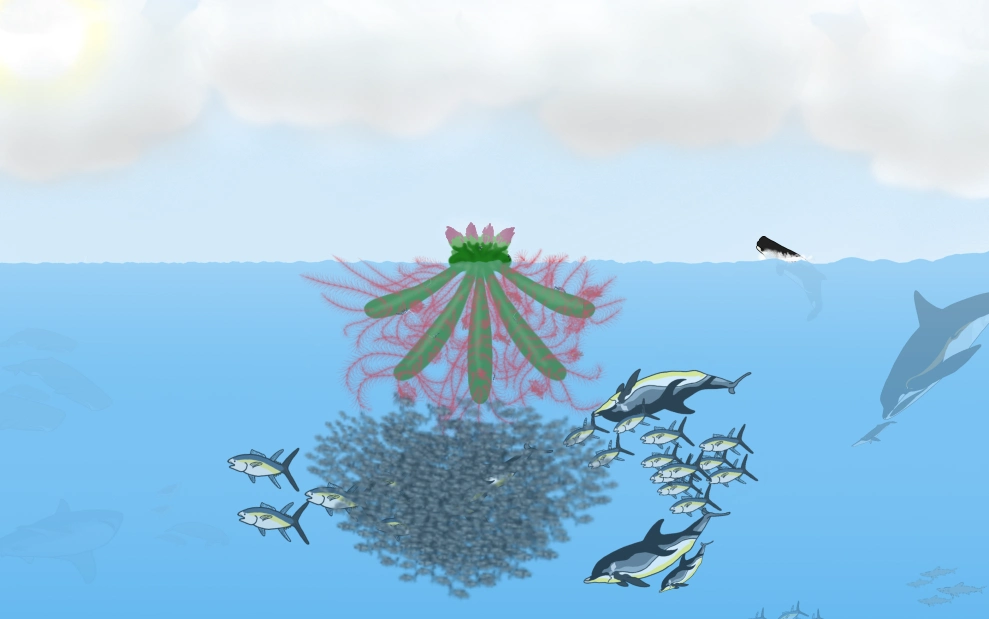
Monstrous flowers dot the surface of the Sargasso Sea. Held aloft by gas-filled floats and clinging to seaweed, ratimmanis ossinedia trawls the temperate waters of the future mid-Atlantic, feasting on the bounty of small fish and phytoplanktons which call the sargassum its home.
Common Names
Ratimmanis ossinedia comes from the Latin ratis (raft) immanis (monstrous) and ossis (bone) inedia (hunger). Nevertheless, it has several colloquial names, most of which are related to its size and buoyancy near popular shipping lanes. In the Caribbean, they are often called “Whale Flowers” due to their size and the resemblance of their oily buds to the breaching rostrum of a migrating humpback. It has also been known as “St. Brendan’s Buoy,” after the patron saint of sailors, as it features in several stories surrounding the survivors of shipwrecks. On the topic of shipwrecks, there are several recorded instances of ratimmanis being referred to as the “Sargasso Iceberg,” mostly in gest, referencing the sinking of the Titanic and reinforcing rumors of sinking ships around the eastern portion of the Bermuda Triangle.
Description
From above the water, a ratimmanis will have a radius of up to 0.75 meters, and during the spring, they will be the host of upwards of a dozen yellow, waxy blooms. Each flower will weigh up to 4 kilograms and bear bundles of fruits roughly the size of grapes. The ratimmanis fruit is eaten by seabirds before the pit is deposited elsewhere in the Atlantic. Beneath the surface, a network of red tendrils stretch down and outward, weaving in the current over a span of 3 meters in every direction.
These tendrils are attached to several fleshy limbs which help to anchor the tendrils and store nutrients. The largest recorded ratimmanis ossinedia was estimated to weigh around 900 kilograms.
Feeding Mechanism
The ratimmanis’s tendrils are covered in tiny barbs which, when brushed, are projected outward. The more the plant’s prey struggles, the more its tendrils coil, drawing its meal to the relative safety of its limbs. There, the trapped creature is slowly dissolved, its nutrients absorbed through pores in the plant’s tendrils and limbs.
Competition
The Sargasso Sea is a highly competitive environment home to dolphins, predatory fish, and sea turtles. Although the ratimmanis ossinedia is a passive predator, it has several methods to ward off those attempting to steal its prey. The barbs of its tendrils are incapable of seriously damaging a larger carnivore, but they are fully capable of irritating skin and especially eyes. In addition, while the acid it uses to dissolve fish quickly becomes diluted in the ocean water, it still has the potential to seriously damage the structure and efficacy of the gills of any water-breathers which try their luck. As such, sea turtles are the most resistant to the ratimmanis’s defenses and will munch on younger tendril growths and recently captured fish.
Human Consumption & Use
Due to the ratimmanis’s size and carnivorous diet, it is not a widely cultivated plant, although there has been some success growing them in tilapia and shrimp fisheries. The fresh growths on ratimmanis tendrils do not have mature barbs, so they can be harvested with relative ease. Their flavor is slightly salty with a hint of citrus, and it retains a light crunch. These growths can be made into a miso-like broth, dried, pickled, or served raw. They have gained some niche popularity as a topping in fusion dishes. Caribbean locals will most often boil the tendrils with rice and other seasoning, although it is not widely available. Ratimmanis fruits are palatable, although they are not terribly sweet, and overconsumption can cause stomach discomfort.
Due to their short shelf-life, the fruits mostly appear in commercial markets in a dried or powdered form. As they are a plant source of heme iron, they are often heralded as a “superfood.” This perception is largely due to their inaccessibility; however, their nutritional value is linked to a marked increase in castaway and shipwreck survivorship around the Sargasso, contrary to the common rumors surrounding the Bermuda Triangle which makes up part of its range.
Oil can be pressed from ratimmanis flowers and immature fruits, although it is more fit for burning than it is for consumption. Some claim the flesh inside of the ratimmanis’s thick limbs can be applied to sunburns for faster healing and relief, although no research has been conducted to confirm this
This entry was made by Moe Neus and Marine Life Enthusiast